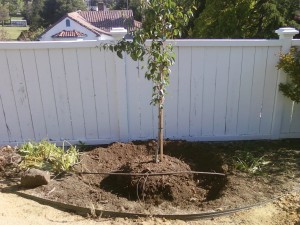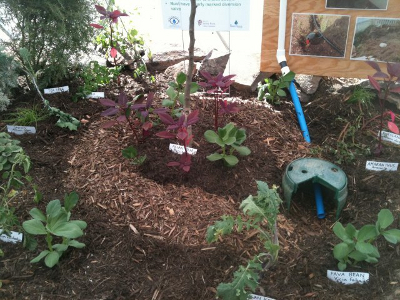
Greywater mulch basins
Art Ludwig's favorite
method of using greywater in the landscape is called the mulch
basin. Installation can be nearly as simple as creating a drain
out back, with the
addition of digging a donut around your tree, piling the soil on the
outside to form a moat, and filling the depression with wood chips (and
your grewater outlet). The soiled water goes directly to a
thirsty plant, who also benefits from the nitrogen content of kitchen
scraps and other debris.
 Although the mulch basin is
much more efficient than the drain out back, you also have to go to
more short and long term effort to make the greywater system work
properly. Create
an Oasis with Greywater walks you through building
branched systems to channel water to multiple trees and ensure no
single plant gets swamped, but even if you plan watering amounts
accurately, you still need to make sure the plant being watered can
handle daily infusions of dishwater.
Although the mulch basin is
much more efficient than the drain out back, you also have to go to
more short and long term effort to make the greywater system work
properly. Create
an Oasis with Greywater walks you through building
branched systems to channel water to multiple trees and ensure no
single plant gets swamped, but even if you plan watering amounts
accurately, you still need to make sure the plant being watered can
handle daily infusions of dishwater.
Of the greywater
tolerant plants Ludwig lists, very few live in our climate and none of
those are active in the winter. That means you need to have an
alternative greywater system in place during the dormant season, which
I'll talk about in tomorrow's post. Meanwhile, if you'd like to
make a mulch basin to put your greywater to use in the summer,
potentially useful temperate-climate plants include blackberries,
elderberries, currants, bamboo, and (to a lesser extent---be careful of
waterlogging) peach, plum, apple, pear, and quince. Those of you
who live in California (like Ludwig does) will want to start with
bananas and branch out into mangos, avocados, citrus, pineapple guava,
and figs.
 The final issue with the
mulch basin is that it requires annual maintenance. Ludwig
recommends redigging your moat walls every year or two, which sounds
like effort that might not quite happen on our farm. (I'm not so
sure it would hurt to just let the tree get its bonus water close to
the trunk for its entire life, though.) On the other hand, I've
been hitting more than missing with my hugelkultur
tree mound expansions,
so maybe expanding a mulch basin would happen too.
The final issue with the
mulch basin is that it requires annual maintenance. Ludwig
recommends redigging your moat walls every year or two, which sounds
like effort that might not quite happen on our farm. (I'm not so
sure it would hurt to just let the tree get its bonus water close to
the trunk for its entire life, though.) On the other hand, I've
been hitting more than missing with my hugelkultur
tree mound expansions,
so maybe expanding a mulch basin would happen too.
I'm curious to hear from
anyone who's tried a mulch basin, but especially from those who live in
an area with winter. What would you add to the pros and cons I've
listed above?
| This post is part of our Create an Oasis with Greywater lunchtime
series.
Read all of the entries: |
Want more in-depth information? Browse through our books.
Or explore more posts by date or by subject.
About us: Anna Hess and Mark Hamilton spent over a decade living self-sufficiently in the mountains of Virginia before moving north to start over from scratch in the foothills of Ohio. They've experimented with permaculture, no-till gardening, trailersteading, home-based microbusinesses and much more, writing about their adventures in both blogs and books.
Want to be notified when new comments are posted on this page? Click on the RSS button after you add a comment to subscribe to the comment feed, or simply check the box beside "email replies to me" while writing your comment.

